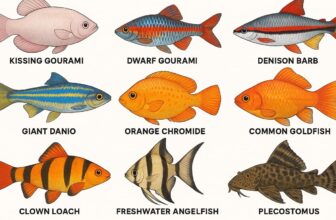For humans, a single heart is enough to pump blood, deliver oxygen, and keep us alive. But in the natural world, many creatures face challenges that one heart alone cannot handle. Some live in deep oceans with low oxygen. Others have elongated or segmented bodies that need circulation in multiple directions. And some are active predators with energy demands far beyond what a single pump could supply.
In these cases, evolution solved the problem by giving them more than one heart. Below are 13 animals with truly multiple hearts, each adapted to its unique lifestyle.
1. Earthworms – Five Pairs of Pseudohearts
Earthworms may look simple, but their circulation is surprisingly complex. Instead of one heart, they have five pairs of aortic arches, ten in total, that act as pumping hearts. These surround the esophagus and rhythmically contract to push blood through the worm’s long, segmented body.
Because earthworms can stretch up to several meters in some species, this system ensures that blood and oxygen reach even the farthest body segments. Without these multiple pumps, their underground lives in low-oxygen soil would be impossible.
2. Octopuses – Three Hearts for Intelligent Hunters
Octopuses are famous for their intelligence and flexibility, but their circulatory system is equally remarkable. They have three distinct hearts:
- Two branchial hearts that pump blood through the gills for oxygen exchange.
- One systemic heart that pumps oxygen-rich blood to the rest of the body.
Interestingly, the systemic heart actually stops beating when the octopus swims. The branchial hearts carry the workload until the animal rests. This design allows octopuses to manage both bursts of speed and periods of stillness while conserving energy.
3. Squids – Triple Hearts for Jet Propulsion
Squids share the three-heart system of their octopus cousins. Two branchial hearts handle the gills, and the systemic heart distributes oxygen-rich blood throughout the body.
The difference lies in their lifestyle. Squids rely heavily on jet propulsion, shooting water out of their mantle cavity to travel at high speeds. This oxygen-demanding movement would overwhelm a single heart. Multiple hearts ensure that their tissues remain supplied even during long migrations or fast escapes from predators.
4. Cuttlefish – Three Hearts Powering Masters of Camouflage
Cuttlefish, another cephalopod relative, also carry three hearts. Their two branchial hearts serve the gills, while the systemic heart pumps blood through the rest of the body.
What sets cuttlefish apart is their active use of camouflage. They constantly shift colors and patterns to hide, hunt, or communicate. This requires rapid muscular and neural activity, which in turn demands a steady oxygen supply. Their triple-heart system makes this biologically possible.
5. Nautilus – Four Hearts in a Living Fossil
The nautilus, a shelled cephalopod often called a “living fossil,” goes even further. It has four hearts:
- One systemic heart.
- Three branchial hearts, each attached to a gill.
This system supports its unique lifestyle. Nautiluses regulate buoyancy by adjusting gas and liquid in their shell chambers, moving between shallow and deep waters. The multiple hearts ensure blood circulation remains stable during these transitions, which could otherwise strain a single pump.
6. Hagfish – Four Hearts for Deep-Sea Survival
Hagfish are jawless, eel-like creatures that thrive in some of the ocean’s harshest environments. They possess a main heart plus three accessory pumps, for a total of four hearts.
These extra hearts allow hagfish to survive in extremely low-oxygen waters where most fish would suffocate. Combined with their ability to produce defensive slime, hagfish show how evolution equipped them with redundancy and resilience in circulation.
7. Squidworms – Two Hearts in the Depths
The squidworm, a rare deep-sea annelid, has two distinct hearts. Life at extreme depths poses constant oxygen challenges, and two pumping organs ensure circulation across its elongated body.
This adaptation lets the squidworm thrive where resources are scarce and pressure is immense, giving it an edge in one of the planet’s toughest habitats.
8. Scaphopods (Tusk Shells) – Two Hearts for Burrowing Life
Scaphopods, or tusk shells, are small mollusks that burrow into sandy seafloors. They have two hearts:
- A systemic heart that pumps blood through the body.
- A gill heart that assists oxygenation.
Because they live buried in oxygen-poor sediments, two hearts make sure circulation continues even when fresh oxygen is limited.
9. Leeches – Paired Hearts Along Their Bodies
Leeches, known for feeding on the blood of other animals, also rely on more than one heart. They have two main lateral hearts that run along their bodies and pump blood in opposite directions.
This system ensures strong circulation during feeding, when a leech’s body swells with ingested blood. Without two hearts, moving oxygen through their expanded bodies would be far more difficult.
10. Amphioxus (Lancelets) – Multiple Accessory Hearts
Amphioxus, also called lancelets, are primitive chordates that provide a glimpse into early vertebrate evolution. Instead of one central heart, they have multiple small pumping structures near the gills.
These accessory hearts work together to push blood through their simple bodies. Studying amphioxus helps biologists understand how multi-heart systems may have paved the way for more complex circulatory designs.
11. Bloodworms – Several Heart-Like Pumps for Mud Survival
Bloodworms, marine worms often found in mudflats, don’t rely on one central heart. Instead, they use multiple pulsating blood vessels that function like small hearts.
This design allows them to move oxygen efficiently in oxygen-poor, muddy habitats. Their red color comes from hemoglobin, which stores oxygen, a perfect complement to their multi-heart system.
12. Chitons – Extra Pumping Structures in Primitive Mollusks
Chitons are armored mollusks with multiple pulsating auricles that function as additional heart-like structures. These assist their main circulatory system in pushing hemolymph across their flattened bodies.
Because chitons cling tightly to rocks in tidal zones, multiple pumps ensure circulation continues even when exposed to air during low tide.
Lessons from Multi-Hearted Creatures
From earthworms with ten pumps to cephalopods with three or four, multiple hearts aren’t a coincidence. They are precise evolutionary solutions to unique challenges:
- Deep sea survival (hagfish, squidworms).
- Fast or energy-hungry movement (squids, cuttlefish, octopuses).
- Long or segmented bodies (earthworms, leeches, bloodworms).
- Extreme environments (nautilus, scaphopods, chitons).
For humans, one heart is enough. But these animals show that in nature, survival sometimes demands more than one pump. Studying them not only explains evolution but may even inspire new approaches in medicine and engineering.





